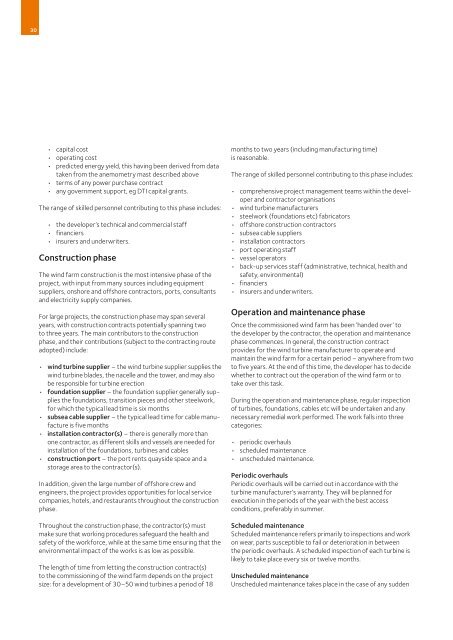offshore wind onshore jobs - a new industry for ... - Greenpeace UK
offshore wind onshore jobs - a new industry for ... - Greenpeace UK
offshore wind onshore jobs - a new industry for ... - Greenpeace UK
Create successful ePaper yourself
Turn your PDF publications into a flip-book with our unique Google optimized e-Paper software.
30<br />
• capital cost<br />
• operating cost<br />
• predicted energy yield, this having been derived from data<br />
taken from the anemometry mast described above<br />
• terms of any power purchase contract<br />
• any government support, eg DTI capital grants.<br />
The range of skilled personnel contributing to this phase includes:<br />
• the developer’s technical and commercial staff<br />
• financiers<br />
• insurers and underwriters.<br />
Construction phase<br />
The <strong>wind</strong> farm construction is the most intensive phase of the<br />
project, with input from many sources including equipment<br />
suppliers, <strong>onshore</strong> and <strong>offshore</strong> contractors, ports, consultants<br />
and electricity supply companies.<br />
For large projects, the construction phase may span several<br />
years, with construction contracts potentially spanning two<br />
to three years. The main contributors to the construction<br />
phase, and their contributions (subject to the contracting route<br />
adopted) include:<br />
• <strong>wind</strong> turbine supplier – the <strong>wind</strong> turbine supplier supplies the<br />
<strong>wind</strong> turbine blades, the nacelle and the tower, and may also<br />
be responsible <strong>for</strong> turbine erection<br />
• foundation supplier – the foundation supplier generally supplies<br />
the foundations, transition pieces and other steelwork,<br />
<strong>for</strong> which the typical lead time is six months<br />
• subsea cable supplier – the typical lead time <strong>for</strong> cable manufacture<br />
is five months<br />
• installation contractor(s) – there is generally more than<br />
one contractor, as different skills and vessels are needed <strong>for</strong><br />
installation of the foundations, turbines and cables<br />
• construction port – the port rents quayside space and a<br />
storage area to the contractor(s).<br />
In addition, given the large number of <strong>offshore</strong> crew and<br />
engineers, the project provides opportunities <strong>for</strong> local service<br />
companies, hotels, and restaurants throughout the construction<br />
phase.<br />
Throughout the construction phase, the contractor(s) must<br />
make sure that working procedures safeguard the health and<br />
safety of the work<strong>for</strong>ce, while at the same time ensuring that the<br />
environmental impact of the works is as low as possible.<br />
The length of time from letting the construction contract(s)<br />
to the commissioning of the <strong>wind</strong> farm depends on the project<br />
size: <strong>for</strong> a development of 30–50 <strong>wind</strong> turbines a period of 18<br />
months to two years (including manufacturing time)<br />
is reasonable.<br />
The range of skilled personnel contributing to this phase includes:<br />
• comprehensive project management teams within the developer<br />
and contractor organisations<br />
• <strong>wind</strong> turbine manufacturers<br />
• steelwork (foundations etc) fabricators<br />
• <strong>offshore</strong> construction contractors<br />
• subsea cable suppliers<br />
• installation contractors<br />
• port operating staff<br />
• vessel operators<br />
• back-up services staff (administrative, technical, health and<br />
safety, environmental)<br />
• financiers<br />
• insurers and underwriters.<br />
Operation and maintenance phase<br />
Once the commissioned <strong>wind</strong> farm has been ‘handed over’ to<br />
the developer by the contractor, the operation and maintenance<br />
phase commences. In general, the construction contract<br />
provides <strong>for</strong> the <strong>wind</strong> turbine manufacturer to operate and<br />
maintain the <strong>wind</strong> farm <strong>for</strong> a certain period – anywhere from two<br />
to five years. At the end of this time, the developer has to decide<br />
whether to contract out the operation of the <strong>wind</strong> farm or to<br />
take over this task.<br />
During the operation and maintenance phase, regular inspection<br />
of turbines, foundations, cables etc will be undertaken and any<br />
necessary remedial work per<strong>for</strong>med. The work falls into three<br />
categories:<br />
• periodic overhauls<br />
• scheduled maintenance<br />
• unscheduled maintenance.<br />
Periodic overhauls<br />
Periodic overhauls will be carried out in accordance with the<br />
turbine manufacturer’s warranty. They will be planned <strong>for</strong><br />
execution in the periods of the year with the best access<br />
conditions, preferably in summer.<br />
Scheduled maintenance<br />
Scheduled maintenance refers primarily to inspections and work<br />
on wear, parts susceptible to fail or deterioration in between<br />
the periodic overhauls. A scheduled inspection of each turbine is<br />
likely to take place every six or twelve months.<br />
Unscheduled maintenance<br />
Unscheduled maintenance takes place in the case of any sudden




![[2007] EWHC 311 - Greenpeace UK](https://img.yumpu.com/22079793/1/184x260/2007-ewhc-311-greenpeace-uk.jpg?quality=85)











